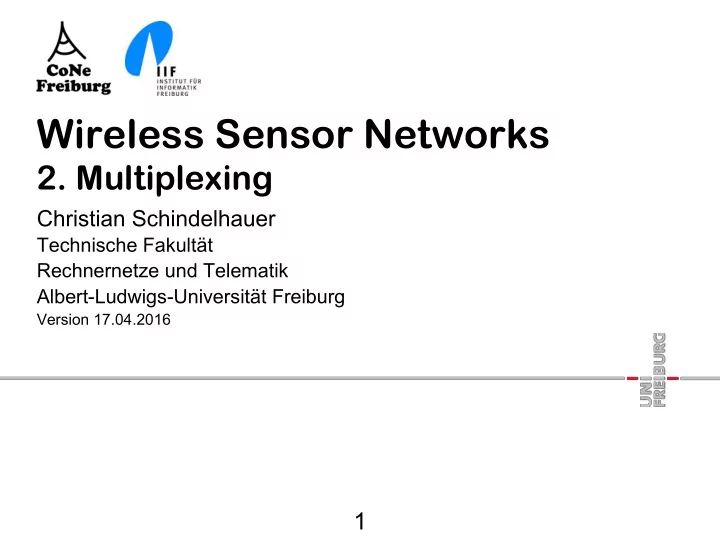

Wireless Sensor Networks 2. Multiplexing Christian Schindelhauer Technische Fakultät Rechnernetze und Telematik Albert-Ludwigs-Universität Freiburg Version 17.04.2016 1
Direct Sequence Spread Spectrum § A chip is a bit sequence (given by {-1, +1}), which encode a smaller set of symbols § E.g. Transmission signal: 0 = (+1,+1,-1), 1=(-1,-1,+1) 0 1 0 1 +1 +1 -1 -1 -1 +1 +1 +1 -1 -1 -1 +1 § Coding by calculating the inner product c i s i of the received signal and the chip c 0 = - c 1 : § In the case of a superimposed signal, the original signal can be decoded by filter § DSSS is used by GPS, WLAN, UMTS, ZigBee, Wireless USB based on the Barker code • Here for all v<m - Barker Code for 11Bit: +1 +1 +1 − 1 − 1 − 1 +1 − 1 − 1 +1 − 1 2
Code Division Multiple Access (CDMA) § CDMA (Code Division Multiple Access) - e.g. GSM (Global System for Mobile Communication) - or UMTS (Universal Mobile Telecommunications System) § Uses chip-sequence with - C i ∈ {-1,+1} m - − C i = ( − C i,1 , − C i,2 , … , − C i,m ) § so that the normalized inner product for all i ≠ j the result is 0. § Synchronized recipients get a linear combination of A and B § Multiplying by the desired chip sequence yields the desired message. 3
CDMA: Example 1 § Sender A: - 0 = (-1,-1) - 1 = (+1,+1) § Sender B: - 0 = (-1,+1) - 1 = (+1,-1) § A sends 0, B sends 0: - Result: (-2,0) § C receives (-2,0): - Decoding of A: (-2,0) • (-1,-1) = (-2)(-1) + 0(-1) = 2 - A has therefor sent 0 because result is positive 4
CDMA: Example 2 § Sample-code: - Code C A = (+1,+1,+1,+1) - Code C B = (+1,+1,-1,-1) - Code C C = (+1,-1,+1,-1) § A sends Bit 0, B sends Bit 1, C sends nothing - V = C 1 + (-C 2 ) = (0,0,2,2) § Decoding for A: V • C 1 = (0,0,2,2) • (+1,+1,+1,+1) = 4/4 = 1 - results in Bit 0 § Decoding for B: V • C 2 = (0,0,2,2) • (+1,+1,-1,-1) = -4/4 = -1 - results in Bit 1 § Decoding for C: V • C 3 = (0,0,2,2) • (+1,-1,+1,-1) = 0 - results in: no Signal. 5
Repetition § Multiplexed - Spatial Multiplexing - Frequency division multiplexing - Time division multiplexing - Code division multiplexing - Multiple-input multiple-output (next lecture) § Modulation - Amplitude modulation - Phase modulation - Frequency modulation 6
Repetition: Complex Numbers § i: imaginary number with - i 2 = -1 § A complex number is a linear combination of a real part a and imaginary b - z = a + bi § Calculation rules: - (a+bi)+(c+di) = (a+c) + (b+d) i - (a+bi) (c+di) = (ac - bd) + (ad + bc) i - 1/ (a+b i) = (a-bi)/(a 2 +b 2 ) § Complex conjugate - (a+bi)* = (a - bi) 7
Exponentiation of Complex Numbers § Important equation - e i π = -1 - e i φ = cos φ + i sin φ § Exponentiation of a complex number - e a+bi = e a e bi = e a (cos b + i sin b) § Therefore - real part e i φ : Re(e i φ ) = cos φ - imaginary of e i φ : Im(e i φ ) = sin φ 8
Equivalent Representations of the FFT § Real number § Complex representation representation - real part of the exponential function of different - Sine and cosine functions of frequencies different frequencies § Computation of the inverse by the integral over the § Computation of the inverse product with the complex by cosine/sine integral conjugated carrier wave product 9
10
11
12
13
Wireless Sensor Networks 3. Overview Christian Schindelhauer Technische Fakultät Rechnernetze und Telematik Albert-Ludwigs-Universität Freiburg Version 26.04.2016 14
Roles of Participants in WSN § Sources of data: Measure data, report them “somewhere” - Typically equip with different kinds of actual sensors § Sinks of data: Interested in receiving data from WSN - May be part of the WSN or external entity, PDA, gateway, … § § Actuators: Control some device based on data, usually also a sink 15
Sensor node architecture § Main components of a WSN node - Controller - Communication device(s) - Sensors/actuators - Memory Memory - Power supply Communication Sensor(s)/ Controller device actuator(s) Power supply 16
Recommend
More recommend